Cinemas in New York City were ordered to close on March 16, 2020 as part of the city’s mitigation efforts to contain the Covid-19 pandemic in its early days. The virus would soon turn the city’s five boroughs into its global epicenter, extending the length of those closures from what was initially expected to be weeks to a matter of months.
Cases dropped from that first Spring peak and stabilized in the New York City region throughout much of the Summer. Starting in May and extending through August, cinemas slowly began re-opening on a state-by-state basis across the country. As Labor Day approached, however, the state of New York had yet to provide a re-opening timeframe or set of guidelines for cinemas. Despite the lack of clarity around New York’s re-opening, Warner Bros.’ gambled on an early September release for Christopher Nolan’s Tenet, the first major studio film released in cinemas during the pandemic. The film’s release came and went without the slightest indication of a New York re-opening, indefinitely removing the top box office market in the country––and putting the rest of the 2020 release schedule at risk. Days after Tenet’s domestic debut, with New York and Los Angeles theaters still closed, Warner Bros. decided to push the October release of Wonder Woman 1984 to Christmas.
Landmark Theatres President and COO Paul Serwitz speaks about New York Citys’ reopening on this week’s episode of the Boxoffice Podcast, below.
When New York state finally announced re-opening guidelines timed to late October, it excluded New York City from those plans without providing any further explanation. By the end of October, nearly every remaining title on the 2020 slate had been rescheduled to the following year, premiered early or simultaneously in streaming platforms, or skipped theaters altogether.
It took a total of 50 weeks since Mayor Bill De Blasio’s original announcement to close New York City movie theaters for local moviegoers to finally learn when–-and how––they could return to the cinema. It wasn’t until late February 2021, after prioritizing several other businesses––including restaurants, gyms, casinos, pool halls, bowling alleys, and arcades––that Governor Andrew Cuomo finally announced New York City cinemas could re-open at 25 percent capacity, with a maximum of 50 people per auditorium, on March 5. After nearly a year of closures without a single update, New York City exhibitors were given ten days to make all the necessary arrangements, including the installation of enhanced air filtration systems, in order to be among the first in the city to re-open.
AMC Theatres was the first major circuit to jump at the opportunity to announce their return to New York City. The chain released a statement from CEO Adam Aron within hours of Cuomo’s announcement, indicating it would be opening all its NYC locations on March 5. Showcase Cinemas was the only other major circuit to announce it would open three NYC area locations on that date. Across the Brooklyn Bridge, independent dine-in operator Nitehawk Cinemas opened its Prospect Park location. Other top chains––including Regal, Alamo Drafthouse, and Cinépolis––expressed optimism to open in the coming weeks and months. Luxury cinema chain Ipic announced it would re-open its location in the financial district on March 31.
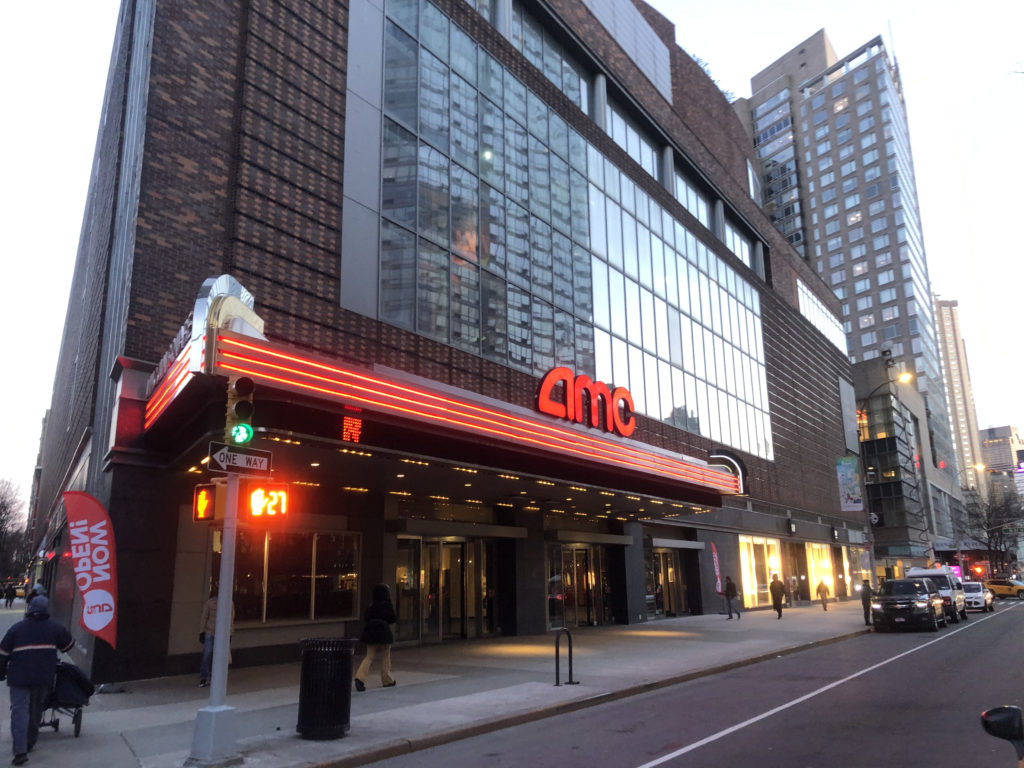
Complementing its status as the country’s top box office market, New York’s re-opening also plays a crucial role in the specialty market as a launching ground for platform releases and a media hub to properly market art-house and foreign titles. Two of the most prominent art-house theaters in lower Manhattan remain closed: Film Forum, scheduled to return on April 2, and Metrograph, which hasn’t issued a re-opening date. Only a short walk from them, a trio of cinemas in Greenwich Village were among the first to re-open on March 5. The IFC Center was joined by Reading’s Angelika Film Center and Cohen Media Group’s Quad Cinema, programmed by the group’s Landmark Theatres team, to welcome New Yorkers back to the movies with the specialty programming they’re known for.
“It wasn’t easy. None of them have been,” admits Landmark Theatres President and COO Paul Serwitz, recounting his circuit’s experience in getting locations back up and running. Landmark, the largest specialty circuit in North America, had to permanently close its flagship NYC location earlier in the pandemic. The circuit assisted the re-opening its parent company’s Quad Cinema in the Greenwich Village on March 5. “We have gotten accustomed, dating back six months now, to getting very little advance notice from any particular state or locality. Having a week to week-and-a-half has been typical. A couple of weeks is like a luxury,” he says.
“I think a lot of people in exhibition have gotten pretty savvy at implementing a pretty quick turnaround to get ready,” he adds. “We’ve learned a lot along the way: getting the jump on ordering PPE materials and inventory items that we need in advance as we could see the potential for various states and markets to re-open. The Quad, specifically, came as a surprise. A lot of people were thinking New York and L.A. could be as far back as April, May, or June to re-open. It seemed to happen pretty quickly. There was a lot of scrambling, but we were able to get it done with all the necessary arrangements…It took about a week and a half of the 10 days of non-stop activity and trying to get things delivered to the theater for all that to be ready, but we made it.”
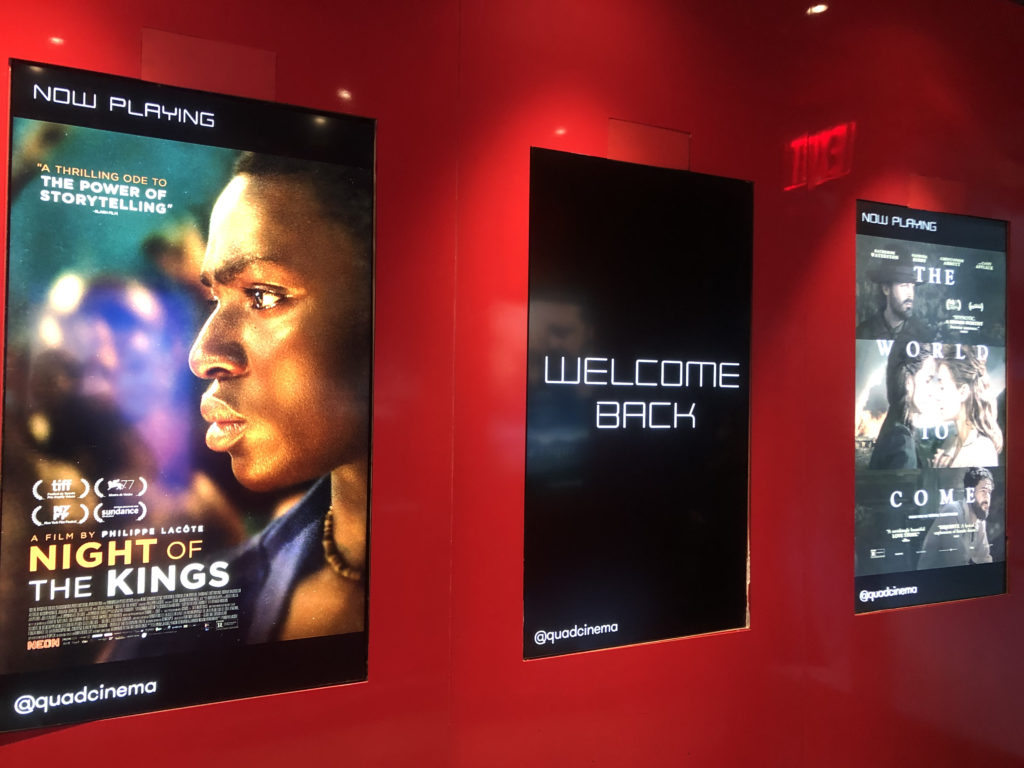
Being ready to open by March 5 was only half the equation for New York City exhibitors. Even with all the preparations in place, movie theater operators need to grapple with the financial challenge of operating at 25 percent capacity for the foreseeable future. In a city like New York, where real estate comes at a premium, the 25 percent capacity restrictions can make it financially unviable to re-open at all. In its response to the re-opening announcement, the National Association of Theatre Owners (NATO) was quick to emphasize the need to increase capacity restrictions to 50 percent in order to help more exhibitors return to operation. “New York City is a major market for moviegoing in the U.S.; re-opening there gives confidence to film distributors in setting and holding their theatrical release dates, and is an important step in the recovery of the entire industry,” read NATO’s statement. “We look forward to expanding the capacity from 25 to 50 percent in the very near future so that theaters can operate profitably.”
IFC Center was one of the theaters that made a decision to re-open despite the financial challenges of operating at 25 percent capacity. The cinema went a step farther by choosing not to sell concessions for the time being, in order to ensure moviegoers wear their masks at all times inside their auditoriums.
“Being closed was absolutely more challenging on a financial level than being open with limitations, so we were excited to open as soon as we were allowed,” says John Vanco, Senior Vice-President and General Manager, at the IFC Center. “The 25 percent capacity limitation certainly makes the finances more difficult, but we’re optimistic that things will improve steadily in the next several months, with growing comfort of audiences, more movies in exclusive theatrical windows, and eventually easing capacity restrictions.”
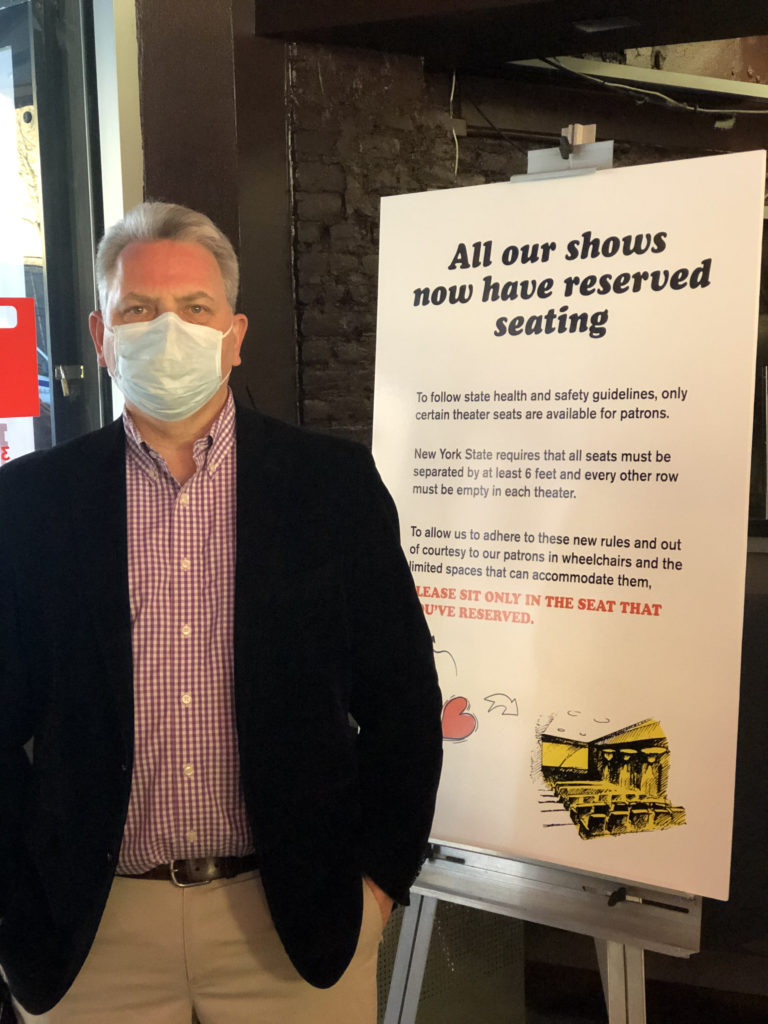
Landmark’s Serwitz agrees on the financial challenges of the state’s current operating restrictions. Like his colleagues that also re-opened on March 5, Serwtiz believes it’s a risk worth taking. “It’s pretty hard to break even at 25 percent with small capacity,” he says. “The Quad is a good example, where that puts us at roughly 25 people max per show, per film. It’s pretty hard to drive enough revenue from that to be in the black. A large part of it is just trying to tap into that pent-up demand for those audiences that are dying to go, ready to go, and do go. Making it so we can get important films and important filmmakers’ content back in theaters, where they belong to be seen, and create the access the movie business has long been associated with: the ability for movies to be on-screen and for people to be able to go to theaters and find them.”
“In any market, as the ability to open theaters continues to expand, there’s going to be a curve from the point of opening over the subsequent number of weeks and months for people to get accustomed to the fact that theaters are open and movies they want to see are available to be seen in theaters. You have to provide some runway for audiences to get back in,” says Serwitz.
For the IFC Center, a theater known for having in-person filmmaker appearances and Q&As promoting independent titles, coming back online is an opportunity for moviegoers to engage with film culture after a year dominated by streaming providers. The theater hasn’t shied away from programming Netflix titles already available to subscribers at home. “While we’re holding off on having any in-person appearances in our first weeks being reopened, we invited filmmakers to contribute a video introduction to welcome moviegoers back to the cinema. We were thrilled at how many filmmakers sent us something––from Spike Lee and Miranda July to Eliza Hittman, Aaron Sorkin, George C. Wolfe, Thomas Vinterberg and David Fincher and the cast of Mank—and audiences are getting a big kick out of watching them,” says IFC’s Vanco.
While it’s still early to see a significant box office impact from New York City’s re-opening, the industry is already experiencing tangible benefits from the market’s return to business. Focus Features opened specialty title Boogie in 1,252 locations on March 5, finishing the weekend as the fourth-highest grossing film in the market with a $1.2 million haul. 14 of the title’s 20 highest-grossing locations came from New York, 7 of them in Manhattan––including the AMC Empire in Times Square, the film’s top grossing theater. New York accounted for nearly a fifth of Boogie’s opening weekend take.
“The impact of New York coming back online is not going to be immediate, but it will be a significant piece to how distributors look at how and when they’re going to release their specialty titles,” says Landmark’s Serwitz, whose circuit focuses primarily on programming specialty titles. “It’s been hugely problematic for those distributors through this period. There was a point last fall before COVID numbers really started resurging that there were close to 70 percent of theaters around the country open, but not New York and L.A.. That poses a particular problem for all distributors and studios, but particularly for the specialty distributors who rely so much on New York and L.A. to launch a movie.”
Focus Features president of distribution Lisa Bunnell agrees, describing New York as part of the overall foundation the specialty market needs to rebuild in the coming months. “Things are still fluctuating. When you’re releasing a specialty film, not only do you need New York, but you also need L.A., you also need Washington D.C.,” she says. “You don’t have Washington, you don’t have Los Angeles––there are still a lot of missing pieces and markets.”
“I think the specialty market will take a while to figure out where we’re going to go and how we’re going to get our distribution schedules back to where we were before or maybe change them,” adds Bunnell. “We’ve learned a lot during this time period; maybe we do go a little broader with some of these films than we used to in the past. The knowledge that we’ve gained from the pandemic, despite being a tough way to learn, showed that there is interest in specialty film across the country and we need to take that into account when we are releasing films. Having your anchors, New York and L.A., open for business is going to be tremendous for us across the board.”
Bunnell expresses hope that the domestic cinema recovery can begin in earnest as the Spring turns to Summer, after a year of frustrated efforts and false dawns. “A lot of that [optimism] has to do with the vaccine. People see that there’s light at the end of the tunnel,” she says. “As we’re starting to understand the pandemic more, we all know it’s not going to be like flipping a switch and everything’s going to be okay. Each step we take into a positive direction is something that brings everybody a little bit out of their pandemic depression.”
“Movie theaters are something that can safely bring people back into the world again,” says Bunnell. “I think it’s important to recognize that theaters are doing a good job of keeping people safe. We’ve seen that so far throughout the country, even before Manhattan re-opened. I know that AMC and everybody in New York who is open right now is being very careful. That’s what we all have to understand: there are going to be protocols for a while, but we can still have fun and see movies together again.”
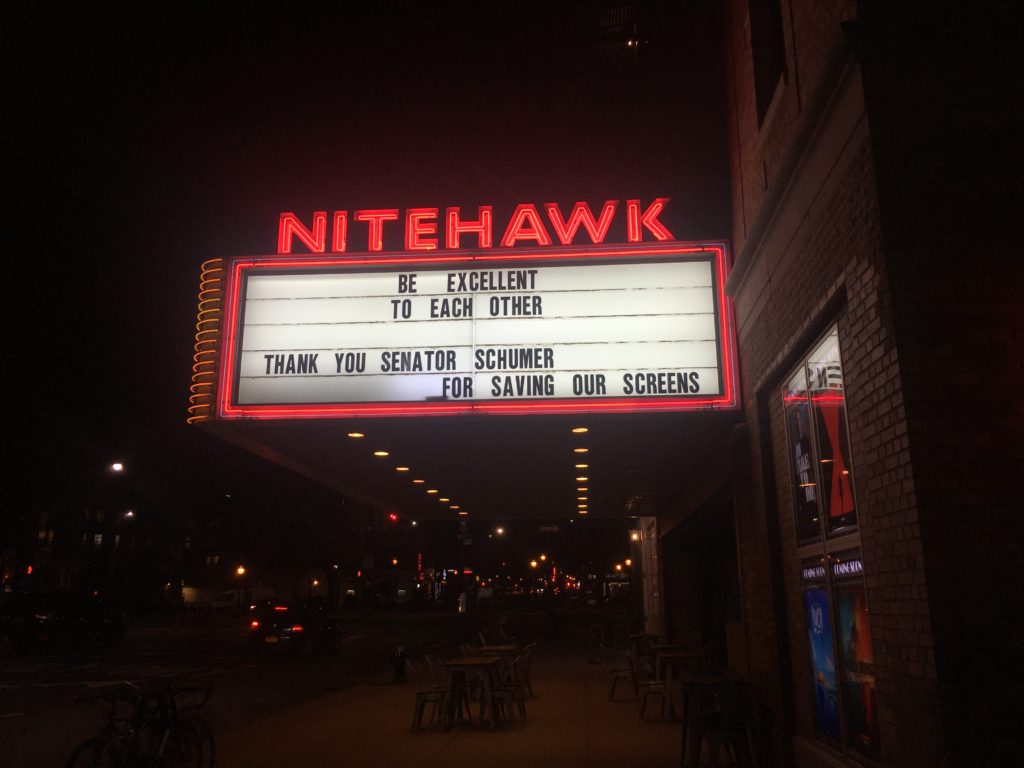

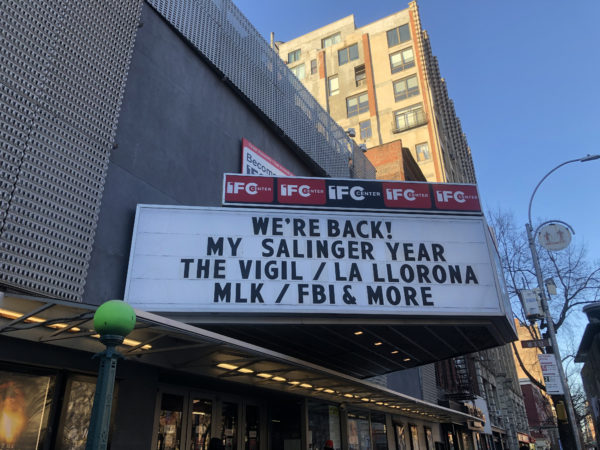

Share this post